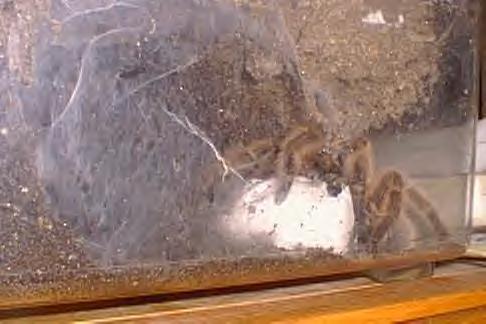Grammastola rosea--The Chilean Rose
Once upon a time, in the not so distant past, I came up with an idea to overcome my fear of spiders. Why not get one as a pet? So I ventured down the street to the local pet store and purchased a Chilean Rose Tarantula. When I returned home and opened my Chilean Rose I was a bit uneasy. We got used to each other over time. And then one drunken night after a Motley Crue concert, I picked up my new friend. She didn't bite me, she didn't kill me, she didn't even act like she cared. That was the beginning of a hobby destined to end up out of control.
|
 Male Chilean Rose-Pictures supplied by Billy Ewert
Male Chilean Rose-Pictures supplied by Billy Ewert
The Chilean Rose tarantula is currently the most widely sold tarantula in the United States. They are imported in such numbers that they are very inexpensive. They also tend to be forgiving of keeping conditions. For these reasons they are a good beginners tarantula. As with all other living things, they can and will have their own behavior patterns. Some may be handled easily, while others tend to be a little more 'grumpy'.
Grammastola rosea is, as its' common name implies, from Chile. This species of tarantula is terrestrial. They are thought to wander around at night and seek refuge before dawn. Some others say that the females will maintain a burrow. In captivity they don't generally construct a burrow until they are going to lay eggs. The males of this species, as seen in the pictures here, upon maturity are strikingly pink on their carapace. The males are slender and have longer legs than the female. They also have tibial spurs on their front legs for mating. |
 Female Chilean Rose
Female Chilean Rose
The Chilean Rose tarantula has a body size of about 2-3 inches. They are usually a brownish gray color dusted with pink. The females are pretty stocky and not as brightly colored as the adult males. The females will spin a cocoon that contains several hundred spiderlings.
|
 Back to our story........
Back to our story........
Returning to the pet store with an entirely different attitude towards spiders, I was in search of other captive roses. Leaving that day with 3 more spiders I went home and began converting my aquariums from fish to vivariums. Id check the pet stores from time to time looking for more. Soon I had 14 Chilean Roses. They began molting in the fall and early winter months. I fairly tense and sleepless time for myself, as I had to watch this multihour process. After the first three molted I was greeted with a male. Cool I thought, now what? Breed Them??? Yes, Breed them. Over the past years we've successfully bred The Chilean Rose. We currently have two females with eggsacs. It's amazing to see the size of the gravid females as opposed to their size after spinning their cocoon. The gravid female first stops eating. She then locates a spot in her enclosure and begins to excavate a burrow, covering the walls with silk. Upon completion of this burrow, she spins a bed of silk, which is the beginning of her cocoon. In layers she deposits the eggs with the male's sperm and then more silk. When she finishes this process she will cut the sides of the bed of silk and roll it up into a ball. Leaving the eggsac alone only at times when she ventures for a cricket or a drink of water.
|